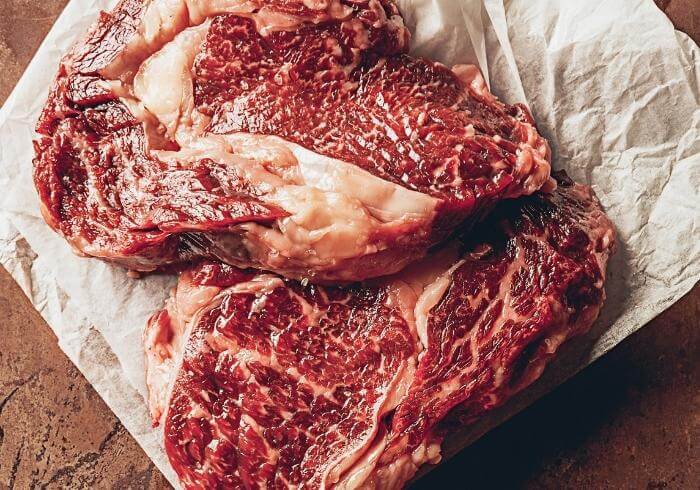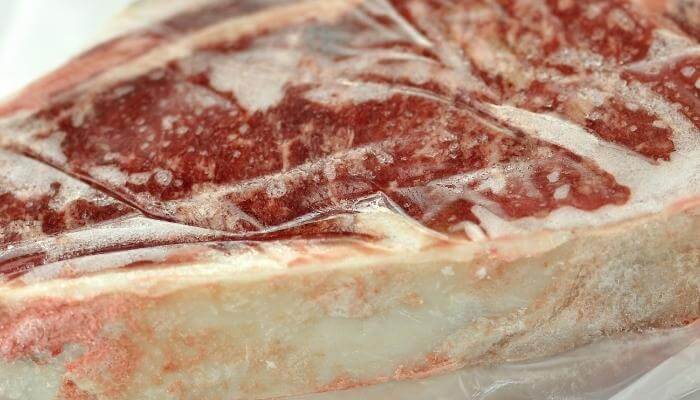Steak is one of the kitchen’s most enjoyable pleasures, both for you and for the hordes of tiny bacteria that have their eyes on it as well. If you’ve noticed something weird about your steak, you may be wondering how to tell if steak is bad.
The good news is that when steak goes off, you’ll know it. Slime, fuzz, and weird colors and smells can all be signs that you’ve been beaten to the punch by the bacteria.

Here are some specific ways to tell if your steak is bad, along with a few specific tips to keep it good as long as you can.
When Does Steak Go Bad (and Why)?
If you want to avoid making a serious steak mistake, never leave your meat:
- At room temperature longer than an hour and a half
- In the fridge longer than 3 – 5 days
- In the freezer longer than 8 – 12 months
According to the USDA, at room temperatures between 40 and 140 degrees Fahrenheit, the bacteria on your steak can double every 20 minutes. After an hour and a half, that will already be too many to handle.
You can slow down the bacterial explosion by wrapping the steak up and putting it in your fridge. That should keep the encroaching army of doom at bay for long as three to five days.

At consistent freezer temperatures of zero degrees, your steak may technically keep for millions of years. Scientists have found frozen woolly mammoths with the food in their stomachs still fresh.
The problem is that steak loses its ideal taste and texture over time. Your steak might not bring you much joy if you leave it in your freezer for longer than a year.
How To Tell if Raw Steak Is Bad
Raw steak isn’t sneaky about going bad. The most common signs of spoiled steak are:
- Slimy surface
- Fuzzy green or white growths
- Spots that turn strange colors
- Smell that makes you recoil
The first sign of a bad steak is usually a thin film of slime that covers the surface. The slime itself may be transparent, or a little yellow, and the steak will look shiny and gooey. If you touch it, it will feel slippery and a bit sticky.
The slime starts in patches, and if you’ve caught it at the beginning, it may not have had time to cover the whole steak yet. If you plan to eat a steak that’s older than you like, check it for patches of goo, and throw it out if you find any.
A few days after the attack of the slime, little furry lawns of mold begin to sprout. These are usually green or white like Christmas grass but with less good cheer. Even just a patch of mold usually means the whole slab is spoiled.
Sometimes the discoloration bacteria beat the slime bacteria to the punch. When that happens, you’ll see the meat has turned from bright red to a goofier yellow or green. This also starts in dots and spreads like nuts. Steak that has begun to turn clown colors is no joke and shouldn’t be played with.
Finally, check your steak’s smell. If it smells bloody or a bit metallic, you should cook it and enjoy every bite. If the steak smells sour like ammonia or vaguely like eggs, it’s probably begun to go off.
We say “probably” because some kinds of dry-aged steak go through a process that releases lactic acid. Lactic acid smells like the gates of hell and can often be mistaken for rot. That’s why this one is the last on the list. If you have any doubts, check for the other signs. Real rot will usually be accompanied by one or more of them as well.
How To Tell If Frozen Steak Is Bad

Even though the freezer is generally the safest place in the kitchen to keep food, not every freezer is 100% consistent.
If you open the door more than you should or if you live in a neighborhood that loses power a lot, the temperature of the food inside may occasionally dip below the safety standard of zero degrees.
When that happens, the invisible bacterial armies can temporarily un-pause and march forward in their quest to conquer your food until the temperature reaches zero again.
If your steak has managed to go bad during one of these lapses then frozen over again, it will generally show most of the same signs as unfrozen bad steak. This includes a slimy or sticky surface, patches of weird colors, or a rancid smell. These signs will become a lot more obvious once you defrost the steak.
How To Tell If Steak Is Bad After Cooking
You can keep cooked steak in your fridge for about 3 or 4 days before it starts to go off. The bacteria that attack cooked and raw steak are the same, so the early warning signs will be the same:
- Discoloration
- Change of texture
- Strange odor
- Mold
What Does Bad Steak Taste Like?
If your steak is showing signs of spoilage, don’t taste it. What you will taste is a mouthful of rancid that will make you retch. Spoiled steak has a sour or bitter and highly unpleasant taste.
Can Steak Gone Bad Make You Sick?
Steak that has gone bad will be full of some of the planet’s nastiest bacteria, including:
- Salmonella
- E. coli
- Bacillus
- Clostridium
If your steak has any of these present, you can’t rescue it by cooking it harder. Many kinds of bacteria survive both cooking and freezing.
The heat may kill some kinds of bacteria, but the toxins they leave behind will outlast the cooking process and wreak havoc on your organs. These toxins will give you food poisoning with a terrible fever, lots of vomiting, stomach pain, and sometimes even longer-term gastrointestinal problems.
How To Store Steak

Here are a few storage tips to help you avoid a high-stakes nightmare game of spin the bacteria.
If you plan to eat it within three to five days, wrap your steak in plastic, and keep it in your fridge under 40 degrees. If you’re not going to eat it soon, keep it wrapped in the back of your freezer where it’s coldest.
When you need to thaw it out, don’t just leave it on your counter to melt. It’s safer to thaw it either quickly in your microwave or slowly in your fridge. Either of those methods will help keep bacterial growth to a minimum.
If Steak Is Brown Is It Bad?
If your steak isn’t yellow or green but has instead turned from red to brown or grayish, that’s usually the sign of a different chemical process that doesn’t involve contaminating bacteria.
The bright red color of fresh steak comes from two delicious proteins:
- Hemoglobin
- Myoglobin
Hemoglobin is the protein in the blood, and myoglobin is found in muscle. When a piece of meat is cut open and exposed to oxygen for the first time, it starts to go through a series of chemical reactions that result in color changes.
The first reaction happens on the first contact of the myoglobin with fresh oxygen. The reaction turns the steak purplish-red.
The next reaction comes after about 30 minutes of oxygen exposure. It turns the hue of the slab of steak cherry red. The steak will stay in this cherry red state for quite a while, but don’t blink. It’s not quite done with its chameleon act yet.
The third and last reaction comes after a few days of oxygen exposure. Once the myoglobin becomes completely oxidized, it turns into metmyoglobin. The surface of the steak will gradually lose its bright red hue and turn a dull brown instead. This might be a bit less eye-catching, but the steak will still taste delicious and be perfectly safe to consume.
SEE ALSO: How To Tell If Ground Beef Is Bad
The average time for this full metmyoglobin takeover to happen is usually about three days from when the steak was cut. It can vary a bit depending on a few things like how old the animal was, its diet, the age of the beast, and how much exercise its muscles got. The amount you expose your steak to light or cold temperatures can also speed up the last reaction.
This is a normal process that happens to all steaks in the face of oxygen. If your steak has turned brown and is also showing one or more of our above warning signs, then you might have a problem. If it’s just turned brown and still smells fresh with no slime or mold, then it’s still safe to eat.
Final Thoughts
If your steak has developed a slimy surface, a fuzzy lawn of mold, patches of yellow or green meat, or a bitter smell, the bacterial hordes have gotten there first.
Don’t try to save rotting steak by cooking it or carving it.
Cooking spoiled steak may kill some bacteria, but it won’t kill the toxins they’ve left behind. Concede your loss graciously by throwing it into the garbage.











